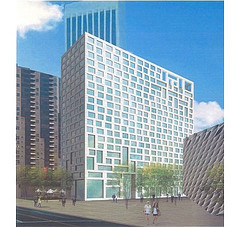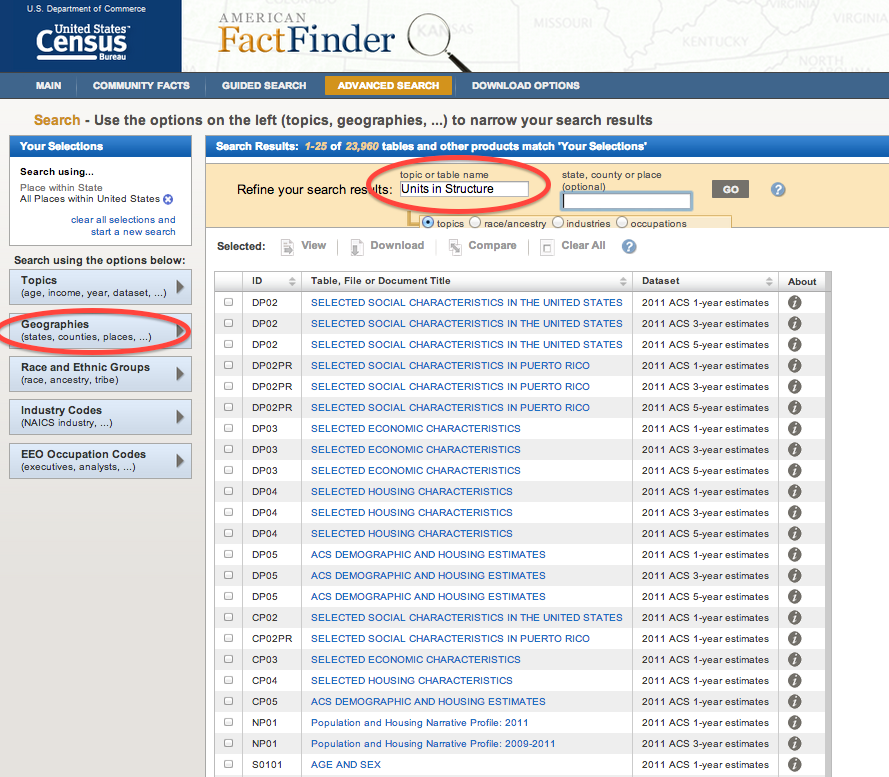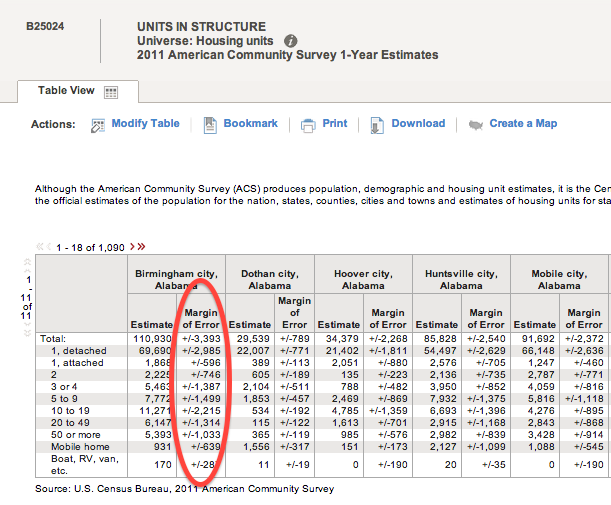Photo by Brandon Griggs on Unsplash

So you need apartment statistics.
I often get requests for apartment data from folks who are:
1. researching where to locate a business that provides services to apartment dwellers like a washateria or car wash; or
2. researching where to buy or build a new apartment facility (and the bank has asked them to include the number of apartment units in an area in their business plan).
What you might not know is that the US Census Bureau reports apartment statistics — which means you don’t HAVE to pay a ton of money to a real estate data company to get an estimate of the number of apartment units in a particular area.
How to get Apartment Statistics from the US Census
If you’d rather spend your time doing more interesting things than learning how to use the American Fact Finder 2 — you can always pay me to pull this data for you using the custom data request form. But just in case you are curious, a glutton for punishment or a college student doing research, here’s how:
1. Head over to the American Fact Finder 2 – Advanced Search.
2. In the Geographies tab on the left, select your geographic area of interest (i.e. New York city, NY or Cook County, Illinois).
3. Then type in these magic words into the search box: “Units in Structure”

4. Then look for the Units in Structure table in the list.

5. Depending on the size of your geographic area & the margin of error that you are comfortable with, you’ll need to choose between the American Community Survey (ACS) 1 year, 3 year or 5 year data. As of today, the ACS 1 year 2011 data are the most current data available. Take a look at the margins of error in the different ACS products to see what table will be the best fit for your purposes.

Fun fact! Now that you know how to pull data via the American Fact Finder 2, there are other statistics that you can get about apartments — not just Units in Structure data.
Understanding Your Apartment Statistics
Now you have your apartment data from the Census — but what do the row headings “1, attached”, “1, detached”, “2” actually mean? Here are the Census’ definitions per the American Community Survey definitions.
- 1-Unit, Detached – This is a 1-unit structure detached from any other house, that is, with open space on all four sides. Such structures are considered detached even if they have an adjoining shed or garage. A one-family house that contains a business is considered detached as long as the building has open space on all four sides. Mobile homes to which one or more permanent rooms have been added or built also are included.
- 1-Unit, Attached – This is a 1-unit structure that has one or more walls extending from ground to roof separating it from adjoining structures. In row houses (sometimes called 7 townhouses), double houses, or houses attached to nonresidential structures, each house is a separate, attached structure if the dividing or common wall goes from ground to roof.
- 2 or More Apartments – These are units in structures containing 2 or more housing units, further categorized as units in structures with 2, 3 or 4, 5 to 9, 10 to 19, 20 to 49, and 50 or more apartments.
- Boat, RV, Van, Etc. – This category is for any living quarters occupied as a housing unit that does not fit the previous categories. Examples that fit this category are houseboats, railroad cars, campers, and vans. Recreational vehicles, boats, vans, tents, railroad cars, and the like are included only if they are occupied as someone’s current place of residence.
- Mobile Home – Both occupied and vacant mobile homes to which no permanent rooms have been added are counted in this category. Mobile homes used only for business purposes or for extra sleeping space and mobile homes for sale on a dealer’s lot, at the factory, or in storage are not counted in the housing inventory.
US Cities with the Most Apartment Units
Just for fun, here are the 40 US cities with the largest number of apartment units according to the American Community Survey 2011 data. No real surprises here. The cities with the largest populations have the most apartment units as do tourist and college towns.
| Geography | Apartment Units | |
| 1 | New York, NY | 2,829,021 |
| 2 | Chicago, IL | 849,096 |
| 3 | Los Angeles, CA | 781,045 |
| 4 | Houston, TX | 442,551 |
| 5 | Dallas, TX | 256,739 |
| 6 | San Francisco, CA | 256,289 |
| 7 | San Diego, CA | 228,212 |
| 8 | Boston, MA | 224,289 |
| 9 | Philadelphia, PA | 219,932 |
| 10 | Phoenix, AZ | 190,495 |
| 11 | Washington, DC | 183,906 |
| 12 | Austin, TX | 175,766 |
| 13 | San Antonio, TX | 173,339 |
| 14 | Columbus, OH | 160,684 |
| 15 | Seattle, WA | 157,533 |
| 16 | Milwaukee, WI | 143,193 |
| 17 | Denver, CO | 135,336 |
| 18 | Miami, FL | 121,343 |
| 19 | Atlanta, GA | 121,086 |
| 20 | Indianapolis, IN | 120,819 |
| 21 | Charlotte, NC | 111,772 |
| 22 | Jacksonville, FL | 110,341 |
| 23 | Portland, OR | 105,165 |
| 24 | San Jose, CA | 104,905 |
| 25 | Nashville-Davidson, TN | 103,981 |
| 26 | Memphis, TN | 100,851 |
| 27 | Cleveland, OH | 98,037 |
| 28 | Baltimore, MD | 96,381 |
| 29 | Cincinnati, OH | 96,051 |
| 30 | Minneapolis, MN | 94,733 |
| 31 | Detroit, MI | 93,888 |
| 32 | San Juan, PR | 93,132 |
| 33 | St. Louis, MO | 93,101 |
| 34 | Urban Honolulu CDP, HI | 92,137 |
| 35 | Jersey, NJ | 92,098 |
| 36 | Las Vegas, NV | 90,887 |
| 37 | Long Beach, CA | 90,168 |
| 38 | Oakland, CA | 90,024 |
| 39 | Fort Worth, TX | 86,814 |
| 40 | Buffalo, NY | 85,595 |
U.S. Census Bureau. 2011 American Community Survey: B25024 UNITS IN STRUCTURE. Retrieved February 26, 2013 from http://factfinder2.census.gov
If you need help pulling apartment statistics for your area, let me know what data you need by filling out the custom data request form, and I’ll email you back with a quote.
